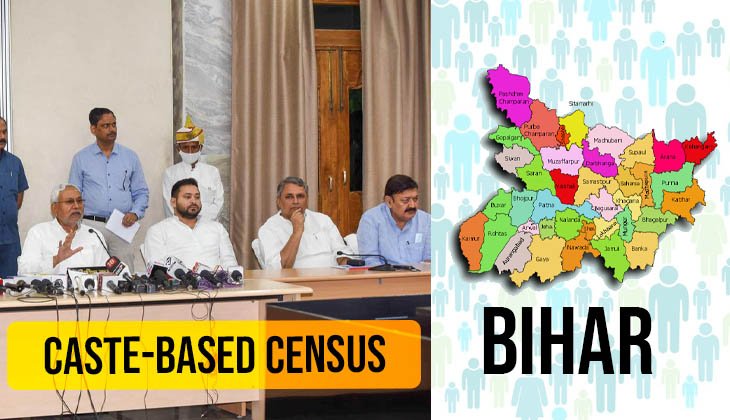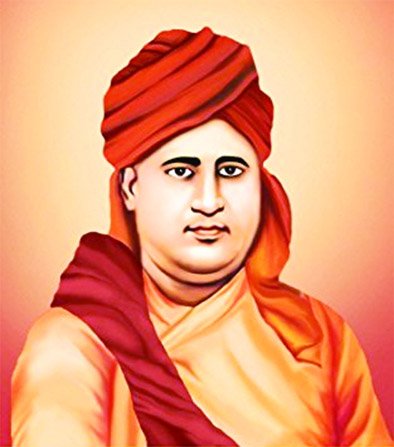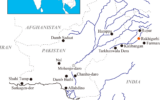
Current Affairs for UPSC Civil Services Exam – May 15, 2024
Subscribers of "Current Affairs" course can Download Daily Current Affairs in PDF/DOC
Subscribe to Never Miss an Important Update! Assured Discounts on New Products!
Must Join PMF IAS Telegram Channel & PMF IAS History Telegram Channel
{GS1 – A&C – Architecture} Mamallapuram Temple *
About Mamallapuram
- It is a town that lies along the Coromandel Coast of the Bay of Bengal, south of Chennai (Tamil Nadu).
- It was founded by the Pallava king Narasimhavarman I in the 7th century AD.
- In 1984, UNESCO declared Mamallapuram a World Heritage Site due to its cultural significance.
- It includes monuments like the Pancha Rathas, Cave Temples, Arjuna’s Penance or Descent of the Ganges, and Shore Temples.
- It was one of two major port cities in the Pallava kingdom.
- It was also the Seven Pagodas. The ancient town had seven pagodas on the shore, of which only one, known as the Shore Temple, now survives.
Shore Temple
- It has two shrines, one dedicated to Shiva and the other to Vishnu.
- It was probably built during the reign of Narasimhavarman II, also known as Rajasimha.
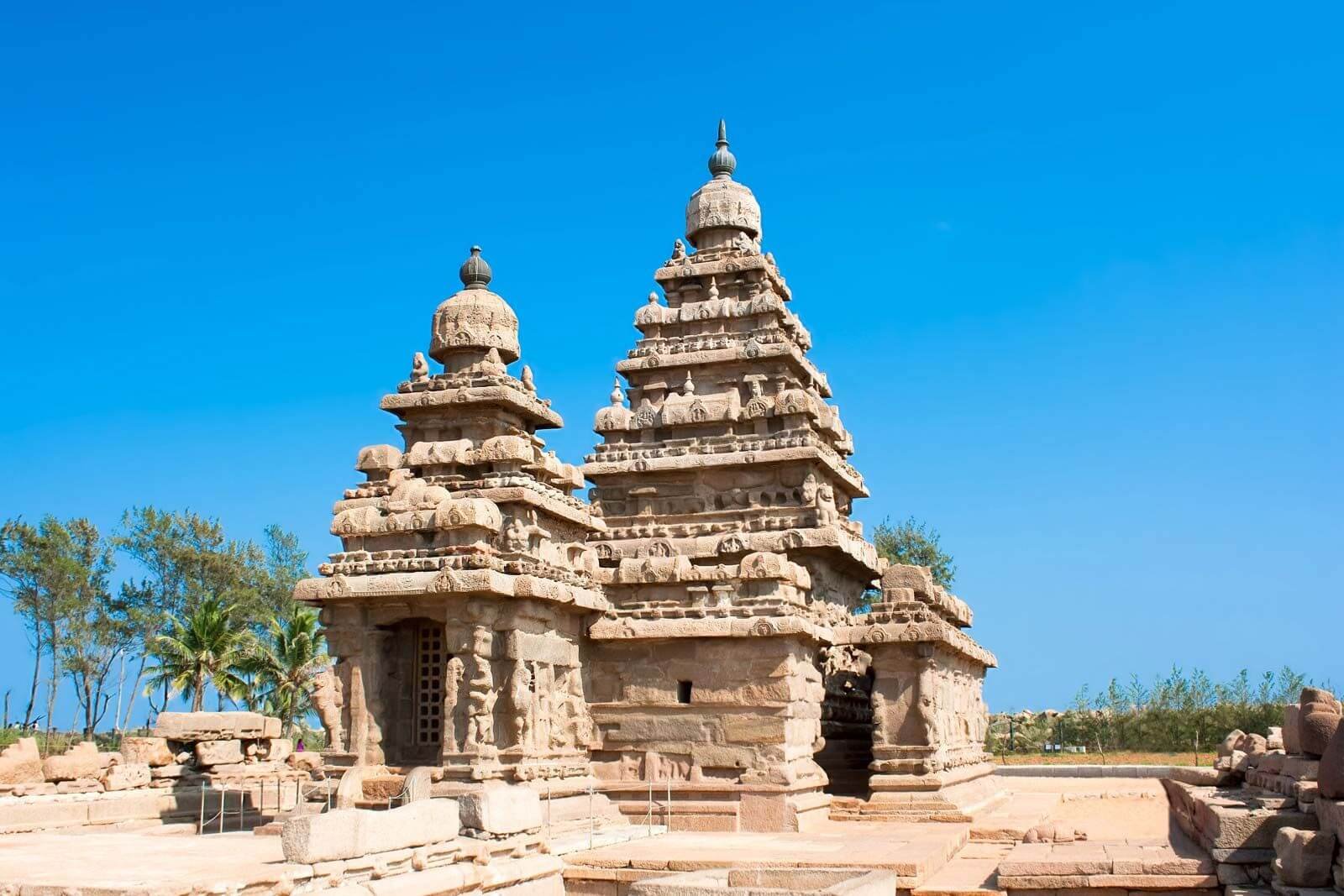
Credit: Britannica
Pancha Rathas
- It is an architectural ode to Mahabharata’s five Pandava brothers, Yudhistir, Bhima, Arjuna, Nakula, and Sahadeva, and their wife, Draupadi.
- All of them were carved out of a long stone or monolith.
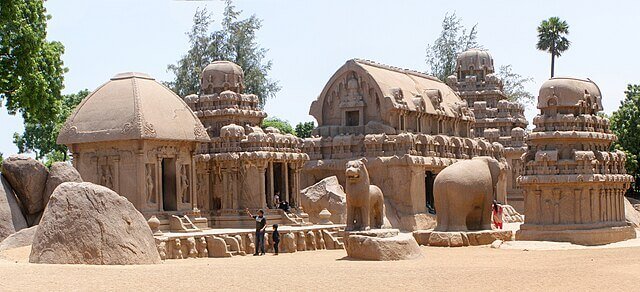
Credit: WikiData
Arjuna’s Penance or Descent of the Ganges

Credit: TOI
- It is a gigantic open-air bas-relief sculpted out of pink granite. The dramatic relief sculpture narrates the tales from Indian epics such as the Mahabharata.
- Conflicting interpretations
- One interpretation depicts the story of the origins and religious significance of the Ganges River.
- Another interpretation focuses on the devotion of the archer Arjuna, the hero of the Mahabharata.
{GS1 – Geo – PG – Geomorphology} Aurora Lights | Geomagnetic Solar Storms *
- Context (IE | NDTV): The Aurora lights were not visible in most parts of India recently, but Indian ground stations have observed the solar flares that caused them.
Aurora Lights or Northern Lights
- Aurora results when the charged particles from the Sun collide with gases in Earth’s upper atmosphere.
- During a geomagnetic storm, magnetic fields break, allowing particles to reach the upper atmosphere.
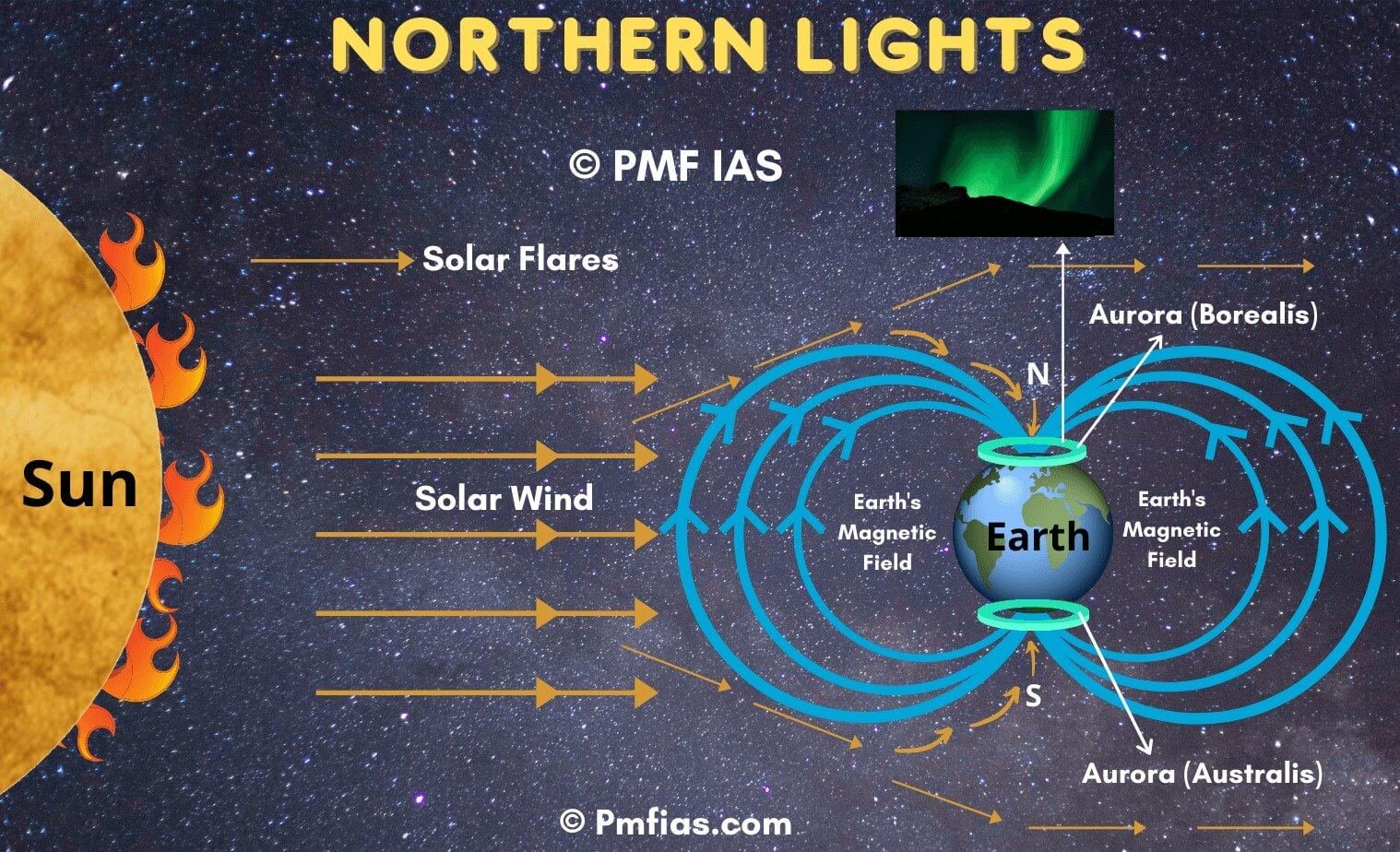
Basics: Why different colours are seen?
- Different gases give off different colours when they are heated.
- Two primary gases in the Earth’s atmosphere: nitrogen and oxygen.
- When Charged particles from the sun collide with,
- Oxygen atoms they emit green and red light.
- Nitrogen molecules emit blue and purple light.
|
Geomagnetic Solar Storms
- Geomagnetic storms are disturbances in the Earth’s magnetic field.
- Caused by the interaction between the solar wind and the planet’s magnetosphere.
- Geomagnetic storms typically originate from the Sun. They are caused by two main phenomena:
- Coronal Mass Ejections (CMEs): Massive bursts of plasma and magnetic fields ejected from the Sun’s surface.
- Solar Flares: Intense eruptions of electromagnetic radiation from the Sun’s surface.
- These storms can have significant impacts on technology, infrastructure, and even human health.
Solar Flares & Solar Cycle
|

Magnetosphere
- A magnetosphere is the region around a planet dominated by the planet’s magnetic field.
- It is generated by the convective motion of charged, molten iron in Earth’s outer core.
- Significance: It traps high-energy radiation particles and shields the Earth from solar storms.
- These trapped particles form two belts of radiation, known as the Van Allen Belts.
- Outer belt is made up of billions of high-energy particles that originate from the Sun.
- Inner belt results from interactions of cosmic rays with Earth’s atmosphere.
- Astronauts must fly through the Van Allen Belts to reach outer space, so it is important to fly through this region quickly to limit their exposure to radiation.

{GS1 – IS – Issues} Legality of Live in Relationships **
- Context (TH): The Lucknow bench of the Allahabad HC stated that a Muslim cannot claim rights in a live-in relationship when he or she has a living spouse.
- The couple told the court they were adults in a live-in relationship and that they sought protection under Article 21 of the IC.
HC’s Observation
- Islamic tenets do not permit live-in relationships during the subsisting marriage. The situation is different if two unmarried adults choose to live life as they please.
- Constitutional rules might support the couple, even if it means challenging old customs; however, in this case, Article 21 of IC wouldn’t offer unlimited support for their rights.
- The sanctity of marriage pre-supposes divorce.
Legal Provisions in Relation to Live-in Relationships in India
- There is no law specifically addressing live-in relationships, but the Indian judiciary has developed jurisprudence over the years through a series of judgements.
- Badri Prasad vs. Dy. Director of Consolidation (1978): The live-in relationships in India are legal but subject to caveats like age of marriage, consent and soundness of mind.
- If a man and a woman have lived together for a long time, the legislation will assume they are legally married unless the reverse is proven.
- A strong assumption favours marriage, but it is arbitrable, and the person contradicting it bears the burden of proof.
- The legality of the live-in relationship stems from Article 19(a) and Article 21 of the IC.
- Lata Singh v. State of UP (2006): SC ruled that two persons of the opposite sex living together are not doing anything illegal.
- S. Khushboo v. Kanniammal and Anr (2010): Living together is a right to life protected by Article 21 of the IC, and thus, despite being considered immoral by society, it is not an offence under the law.
- Velusamy vs. D Patchaimal (2010): The SC established legal criteria for live-in relationships:
- The couple must hold themselves out to society as being akin to spouses.
- They must be of legal age to marry.
- They must be otherwise qualified to enter into a legal marriage, including being unmarried.
- They must have voluntarily cohabited and held themselves out to the world as being akin to spouses for a significant period of time.
Case Laws
- Indra Sarma v. VKV Sharma (2013): The SC ruled that the woman partner in a live-in relationship is protected under the Protection of Women from Domestic Violence (PWDV) Act, 2005.
- Svetlana Kazankina v. Union of India (2015): Marriages and live-in relationships should not be regarded differently when granting a visa extension, citing that they are now a reality of life.
- K.E. Krishnan & Another vs K.E. Valsan & Others (2022): The SC ruled that children born to partners in live-in relationships can be considered legitimate and are eligible for family succession.
{GS1 – IS – Population} Analysing EAC-PM Paper on Religious Diversity in India
- Context (TH): The report of the Prime Minister’s Economic Advisory Council (PM-EAC) has revived the debate about Muslim population growth.
To learn about the findings of the Paper, visit >EAC-PM Paper on Religious Diversity in India.
An Analysis of the Data
- Population growth is not the right parameter to judge a group’s status in the country’s body politic.
- Higher fertility rates are proof of illiteracy and poor economic conditions.
- Examining a group’s educational, social, and economic conditions is the ideal way to determine its share of the national pie.
- Representation of the group in the state’s power structure is the real test of its well-being.
- With literacy rates increasing amongst Muslims, there has been the steepest decline in the fertility rates of Muslims.
- According to the 2011 census, the Muslim population’s decadal growth declined from 36.02% to 24.04%.
- From 2001 to 2021, the Hindu population’s decadal growth declined from 20.35% to 16.76%.
- The Muslim total Fertility Rate (TFR) is 2.36, which is very close to the replacement rate of 2.1.
- The TFR of Muslim women saw a drop of 2.05 as against Hindu women’s TFR of 1.36.
- The Hindu fertility rates of Bihar (2.88) and Uttar Pradesh (2.29) are much higher than the Muslim fertility rates in Kerala (2.25), Tamil Nadu (1.93), Andhra Pradesh (1.97), and Telangana (2.01).
India’s Stabilising Population Growth
- Reliable global surveys suggest that India has recently overtaken China and is now the most populous country in the world.
- The United Nations Population Fund observed in 2022 that India’s population growth appears to be stabilising.
- A total of 31 states and union territories have achieved fertility rates below the replacement level of 2.1.
- According to some studies (The Lancet 2024), the replacement level may go as low as 1.75 in the next three years.
- According to the National Family Health Survey (NFHS)-5, India’s current TFR is 2.0, slightly below the replacement levels required by the replacement fertility rates.
- If a woman gives birth to 2.1 children on average, this is called the ‘replacement fertility rate’.
- A country achieving a replacement-level fertility rate is a milestone in stabilising population growth.
- The ‘Total Fertility Rate’ (TFR) refers to the average number of children a woman gives birth to.
United Nations Population Fund (UNFPA)
|
- This significant decrease could have profound implications, especially in states like Bihar, which currently has the highest fertility rate in India.
- The Economic Survey 2019 had said:
- India is set to witness a sharp slowdown in population growth in the next two decades.
- India’s population projections up to 2041 indicate a significant slowdown in growth, marking a transition to the next demographic stage.
Can we Control the Population by Coercive Actions?
- In an affidavit to the SC, the GoI acknowledged that coercing a specific number of children can be counterproductive, as evidenced by international experience.
- The National Population Policy, 2000 of the first NDA government focused on more relevant socio-cultural factors such as
- Age at marriage,
- Age at birth,
- Girl education,
- Maternal and child health and
- Voluntary and informed consent over coercive methods.
- India is a signatory to international covenants such as the International Covenant on Civil and Political Rights (ICCPR) and must abide by international norms on population control.
- The United Nations Human Rights Committee has categorically mandated that state parties to the ICCPR cannot adopt compulsory, coercive, or discriminatory policies.
{GS2 – IR – India-Canada} Labour Market Impact Assessment (LMIA) Permits
- Context (IE): Following the imposition of intake caps on international student admissions to Canada, Indians are turning to Labour Market Impact Assessment (LMIA) work permits to emigrate.
- The LMIA programme allows Canadian employers to hire foreign workers if recruitment efforts for hiring local employees fail.
- For this, employers need to post their job requirements on the official Canadian portal and eligible foreign workers can apply through it.
- A positive LMIA will show that there is a need for a foreign worker to fill the job. It will also show that no Canadian worker or permanent resident is available to do the job. A positive LMIA is sometimes called a confirmation letter.
Why is LMIA becoming popular among Indians?
- Competitive nature of the international student visa process due to caps on international admissions.
- Labour shortages in Canada and the opportunity to gain valuable Canadian work experience and establish themselves in the labour market.
- A pathway for individuals who may not meet the criteria for student visas or other immigration streams.
Why is LMIA preferred over the student visa route?
- Rising costs associated with student visas, including living expenses and tuition fees.
- The inability to score the required scores in English proficiency tests for study visas (many jobs under LMIA accept lower scores in English proficiency tests).
Can LMIA lead to permanent residency?
- A positive LMIA does not guarantee permanent residency.
- Skilled foreign workers must still meet all requirements under the Express Entry immigration process (a quick way to permanent residence for immigrants seeking a new life in Canada).
{GS2 – IR – India-Iran} 10-year Contract for Chabahar Port
- Context (IE | IE): India and Iran signed a 10-year contract for the operation of Chabahar port in Iran.

- India Ports Global Ltd (IPGL) and Ports & Maritime Organisation of Iran (PMO) signed the contract.
- IPGL will invest approximately $120 million to equip and operate the port for the duration of the contract.
- India has also offered a credit window in rupees equivalent to $250 million for mutually identified projects to improve port infrastructure.
History of the Chabahar Project
- 2002: India’s involvement in the project was discussed first at the National security advisor level in 2002.
- 2003 Vajpayee-Khatami agreement: During Iranian President Khatami’s visit to India, the New Delhi Declaration was signed, with Chabahar as one of the projects included.
- Slow follow-up: As India drew closer to the administration of President George W Bush and the US putting Iran in the “axis of evil” along with Iraq and North Korea, it pressured India to go slow.
- Progress after 2015: The Joint Comprehensive Plan of Action (JCPOA) improved US-Iran relations, and the project received greater attention.
- Trilateral Agreement 2016: India, Iran and Afghanistan signed a trilateral agreement to establish the International Transport and Transit Corridor.
- Waiver from US sanctions: Trump administration exempted the project from the US sanctions on Iran.
- August 2023: Meeting of the Indian PM and Iranian President on the sidelines of the BRICS Summit gave a clear political direction to finalise and sign the long-term contract.
Rising significance of Chabahar Project
- Liberalisation: Post 1990s, the Indian economy opened up and looked for ways to increase India’s engagement with the world.
- Rise of Taliban: The Taliban took over Afghanistan in 1996 and impacted the land route.
- Alternate route: After Pakistan and Afghanistan, the next best is through Iran, which borders Central Asia and the Caspian Sea.
- China in Gwadar: China began to develop the Gwadar port in Pakistan as part of the Belt and Road Initiative (BRI), making the Chabahar port more significant.
International North-South Transport Corridor (INSTC)
Credits: dw.com
To know more, visit > INSTC. |
Current Status of Project
- There are two distinct ports in the Chabahar project, Shahid Beheshti and Shahid Kalantari.
- India’s investment is restricted to the Shahid Beheshti port.
- IPGL has been operating Chabahar Port through its wholly-owned subsidiary, India Ports Global Chabahar Free Zone (IPGCFZ), since 2018.
- It also facilitated the supply of humanitarian assistance, especially during the Covid-19 pandemic.
- To date, a total of 2.5 million tonnes of wheat and 2,000 tonnes of pulses have been trans-shipped from India to Afghanistan through Chabahar port.
- In 2021, India supplied 40,000 litres of environment-friendly pesticide (malathion) through the port to Iran to fight locust attacks.
{GS2 – Polity – Bodies – Statutory} NHRC’s Status Deferral
- Context (TH): National Human Rights Commission of India (NHRC) was formally informed that the deferral of its status would continue for a year more.
- The Subcommittee on Accreditation (SCA) of the Global Alliance of National Human Rights Institutions (GANHRI) initiated the deferral.
- While the SCA did not agree with some leading international NGOs’ plea to put the NHRC in category ‘B’, it also rejected India’s request to lift the deferral.
Paris Principles 1993
|
To know more about the issue, visit > NHRC.
{GS3 – Envi – Conservation} Opportunities by Compressed Biogas Sector
- Context (DTE): The Compressed Biogas (CBG) sector is gaining momentum towards its goal of establishing 5,000 CBG projects nationwide under the SATAT scheme.
Advantages of CBG
- Enhancing waste management.
- Promote local clean energy production.
- Reduce reliance on imported compressed natural gas.
- CBG seamlessly integrates into existing natural gas infrastructure, obviating the necessity for new setups.
Opportunities offered by CBG Sector
Utilise carbon dioxide (CO2) from CBG projects
- With every tonne of CBG produced, about 0.5 tonnes of CO2 is also generated, which is presently wasted and leads to greenhouse gas emissions. This can be captured and utilised for high-end applications.
Enrichment and marketing of fermented organic manure (FOM)
- Fermented organic Manure (FOM) is rich in carbon and micronutrients but lacks nitrogen and potassium, posing disposal issues for some plants.
- FOM can be enriched with nitrogen and potassium to meet chemical fertiliser standards and gain acceptance among farmers.
Regional-level feedstock mapping
- Though national data on feedstock availability, such as surplus agricultural residue, organic waste from municipalities, etc., exists, it’s imperative for CBG projects to access up-to-date and localised estimates.
- Utilising AI to forecast precise feedstock availability at the district or even neighbourhood level, facilitates effective plant planning.
Mixed feedstock technology
- CBG production predominantly relies on five distinct feedstocks (animal waste, agricultural residue, press mud, organic waste from municipalities and Napier grass).
- Currently, a majority of Indian plants utilise single-source feedstocks due to the absence of economically viable mixed feedstock processing technology.
- Accessible technology for handling mixed feedstock would enable plants to utilise a variety of sources, mitigating concerns regarding sourcing and shortages.
Monitoring health of bioreactors and microbes
- Biogas generation occurs through anaerobic digestion, where anaerobic bacteria break down organic matter.
- Tracking the health of the bacteria by implementing real-time monitoring and responsive solutions could significantly enhance plant operations, enabling continuous production without interruptions.
Learn in detail about Compressed Biogas (CBG) and CBG Blending Obligations.
{Prelims – Envi – Species} Silver croaker (Plagioscion squamosissimus)
- Context (Phys): Silver croaker is the most probable cause of a sharp fall in the diversity of native species in the Jaguari reservoir, the Jaguari River, and Rio do Peixe.
- As a top predator in the food network, it has negatively affected local biodiversity by bringing about detrimental changes to its taxonomic, functional and phylogenetic structure.

Credit: Seafood Delicacy
- Silver Croaker is a large predatory fish native to the Amazonian region.
- This is one of the few freshwater species of the croaker family. Its body is covered with silvery scales.
- Significance: It is a key fishing resource for both subsistence and sport.
{Prelims – In News} India Volatility Index *
- Context (IE): India Volatility Index (VIX), an indicator of market volatility expectations, surpassed 21 recently. The surge indicates increased fear among traders regarding expected volatility.
- The current fear is primarily due to uncertainty surrounding the ongoing Lok Sabha elections.
What is the Volatility Index (VIX)?
- Also known as the Fear Index, it measures the market’s expectation of volatility in the near term.
- During volatile market periods, prices move sharply up or down, causing the volatility index to rise. As volatility decreases, the Volatility Index declines.
- The index is based on the order book of the underlying index options (S&P 500 Index options).
- Introduced by the Chicago Board of Options Exchange (CBOE) for the US markets in 1993.
India Volatility Index (VIX)
- It is computed by the National Stock Exchange using the order book of NIFTY Options.
- It indicates investors’ perception of market volatility over the next 30 calendar days.
{Prelims – In News} Oscillibacter bacteria
- Context (IE): Researchers found that people who had Oscillibacter bacteria in their gut had lower cholesterol levels than those with poor levels of the same.
- It breaks down cholesterol so that it cannot be absorbed into the bloodstream. Rather, the end product passes through stool.
Contributing to lower cholesterol
- Oscillibacter bacteria influence bile acids, which are essential for fat digestion and absorption.
- Once they finish their functions, bile acids return to the liver for recycling.
- But some amount remains in the gut, becoming the food for gut bacteria and growing them.
- This gut bacteria breaks down bile acids into secondary bile acids, which regulate cholesterol metabolism.
- It also breaks down dietary fibres through fermentation and produces short-chain fatty acids.
- These inhibit cholesterol formation and keep their levels low.
|
{Prelims – S&T – AI} OpenAI’s GPT-4o
- Context (IE): OpenAI introduced its latest large language model (LLM) called GPT-4o billing it as their fastest and most powerful AI model so far.
- Unlike GPT-4, which was only available to paid users, the GPT-4o will be freely available.
- GPT-4o lets users input any combination of text, audio, and image and receive responses in the same formats.
- It is capable of interacting using text and vision, meaning it can view screenshots, photos, documents, or charts uploaded by users and have conversations about them.
- Unlike its predecessors that required multiple models to handle different tasks, GPT-4o uses a single model trained end-to-end across various modalities – text, vision, and audio
- It has multilingual support and shows significant improvements in handling non-English text, making it more accessible to a global audience.
{Prelims – S&T – Defence} Exercise Tarkash
- Context (TH): The India-U.S. joint counter-terrorism exercise named Tarkash concluded today.
- It is a joint exercise by the National Security Guard (NSG) and US Special Operations Forces (SOF).
- This year, it took place in Kolkata. The previous edition took place in Chennai in January 2023.
{Prelims – S&T – Space} New rocky planet discovered
- Context (TH): Astronomers have found a rocky planet beyond our solar system with an atmosphere.
- This was confirmed by the Infrared observations made from the James Webb Space Telescope.
- Significance: Unlike previous discoveries of gaseous exoplanets, this one is rocky; its discovery raises hopes for finding cooler planets with atmospheres capable of sustaining liquid water in the future.
Tidal locking: why we only see one side of the Moon?
|
{Prelims – Sci – Bio – Diseases} Extra-pulmonary TB
- Context (TH): Nearly one in five TB patients have extra-pulmonary TB (EPTB).
About Extra-pulmonary TB
- Tuberculosis (TB) typically infects the lungs (pulmonary TB). However, 20% of cases affect other organs, such as lymph nodes, the brain, the gut, and the eyes (extra-pulmonary TB).
Concerns or Challenges
- Currently, there are no diagnosis and treatment protocols for all organs affected by EPTB.
- Access to care is limited to specialist facilities.
- Prolonged presence of disease markers even after the infection is resolved with treatment.
- EPTB is often stain-negative, which means it is not detectable on regular TB stain tests.
|
To know more, visit Tuberculosis (TB).







![PMF IAS Environment for UPSC 2022-23 [paperback] PMF IAS [Nov 30, 2021]…](http://pmfias.b-cdn.net/wp-content/uploads/2024/04/pmfiasenvironmentforupsc2022-23paperbackpmfiasnov302021.jpg)







